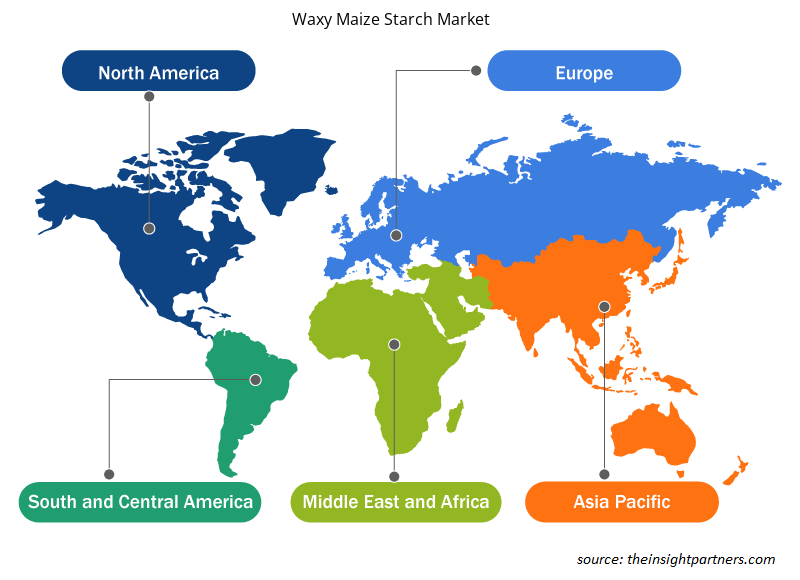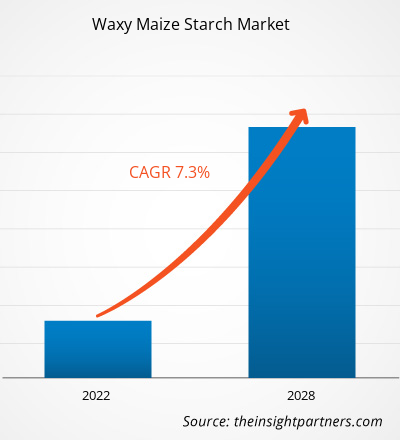2021 年糯玉米淀粉市场价值为 20.0068 亿美元;预计 2022 年至 2028 年的复合年增长率为 7.3%。
蜡质玉米淀粉是一种从玉米中提取的复合碳水化合物。它被用作食品、纺织和制药等各种终端行业的添加剂。它被添加到单根纱线中,以提高机械强度和抗摩擦性,并防止水分渗透。当织物被套印时,它还可以用作彩色油墨的稳定剂和填料。蜡质玉米淀粉在食品工业中的消费量大幅增加,因为它具有高吸水能力,可用作汤和肉汁、馅饼馅、炖菜和砂锅菜以及酱汁中的增稠剂。蜡质玉米淀粉市场很可能在不久的将来大幅增长,因为它具有发泡和胶凝等功能特性,使其成为各种终端行业的重要添加剂。
2021 年,亚太地区占据了最大的糯玉米淀粉市场份额,而中东和非洲等其他发展中地区预计在预测期内将大幅增长。由于中国和印度等发展中经济体的潜在客户群、人们的食品偏好以及对健康、功能性食品的需求不断增长,市场正在蓬勃发展。糯玉米淀粉广泛应用于食品和饮料、纺织和造纸制造业,以稳定和乳化产品,并作为制药行业的粉末粘合剂。根据中国淀粉工业协会的数据,2021 年中国生产了 3917 万吨玉米淀粉。预计所有这些因素都将在预测期内推动糯玉米淀粉市场的增长。
定制此报告以满足您的需求
您可以免费定制任何报告,包括本报告的部分内容、国家级分析、Excel 数据包,以及为初创企业和大学提供优惠和折扣
- 获取此报告的关键市场趋势。这个免费样品将包括数据分析,从市场趋势到估计和预测。
COVID-19 疫情对糯玉米淀粉市场的影响
2020 年初,COVID-19 疫情给许多行业带来了前所未有的挑战。各国政府根据世卫组织和各国卫生部的指导方针实施的封锁、边境限制、旅行禁令、生产停工和其他安全措施阻碍了制造业的运营。然而,2021 年,随着多个国家的政府宣布放宽先前实施的限制,各经济体和行业恢复了运营。制造商被允许满负荷运营,这有助于他们克服供需缺口和其他影响。此外,糯玉米淀粉制造商正致力于增加产量,以在 2022 年底前恢复业务。
市场洞察
主要市场参与者的战略发展不断加强
蜡质玉米淀粉制造商正在进行战略发展,例如产品创新、工厂产能扩张和并购,以加强其市场地位并扩大客户群。例如,2021 年 9 月,著名的淀粉和其他食品配料制造商之一 AGRANA Beteiligungs-AG 投资 2487 万美元扩建其在奥地利各地的特种淀粉制造厂。奥地利工厂将加工的特种淀粉包括蜡质玉米淀粉和有机玉米淀粉。随着工厂产能的扩大,该公司预计将满足奥地利和其他欧洲市场对特种淀粉日益增长的需求。因此,市场参与者的持续战略发展预计将在预测期内为蜡质玉米淀粉市场提供巨大的机会。
基于类型的洞察
根据类型,蜡质玉米淀粉市场分为改性淀粉和天然淀粉。预计天然淀粉部分将在预测期内获得更大的市场份额。食品和饮料制造商广泛使用天然淀粉作为增稠剂、胶凝剂、稳定剂和增稠剂。它可以添加到各种食品中,包括烘焙食品、汤和酱汁、加工肉制品、零食、酒精和非酒精饮料以及干混合物。此外,它还用作油漆和各种涂料的通用增稠剂。在标签粘合剂的生产中,天然蜡质淀粉在高速机器上工作时表现出增强的粘合能力。嘉吉公司、罗盖特兄弟公司和泰特莱尔是领先的蜡质玉米淀粉制造商。
基于类别的洞察
根据类别,糯玉米淀粉市场分为有机和常规。预计在预测期内,有机部分将在市场上实现更高的复合年增长率。与无机玉米相比,它的质量更高。因此,随着客户对优质和天然产品的需求,预计未来几年对有机玉米淀粉的需求将迅速增加。在食品工业中,有机糯玉米淀粉经常用作增稠剂。例如,它被用作沙拉酱、即食食品、汤和婴儿食品中的乳化剂。此外,素食产品是用不含转基因成分的有机淀粉制成的。
基于应用的洞察
根据应用,糯玉米淀粉市场细分为食品和饮料、膳食补充剂、药品和保健品等。预计药品和保健品部门在预测期内的复合年增长率最高。玉米淀粉及其衍生物也用于外用制剂,如软膏和洗剂。它以各种剂型使用,包括可吞咽的片剂、硬胶囊、混合物、颗粒和颗粒预混料。浓度为 5-20% 的玉米淀粉糊经常用于片剂制造,以增强制剂的粘合能力。
糯玉米淀粉市场的主要参与者包括嘉吉公司、泰特莱尔公司、AGRANA Beteiligungs-AG、Manildra Group、Roquette Frères、Sinofi Ingredients、东海电喷株式会社、三和淀粉株式会社、新西兰淀粉有限公司和三阳株式会社。这些参与者致力于开发降低健康风险的产品,以满足新兴的消费趋势并遵守监管框架。他们参与并购、业务扩张和合作,以扩大市场份额。
糯玉米淀粉市场区域洞察
Insight Partners 的分析师已详细解释了预测期内影响糯玉米淀粉市场的区域趋势和因素。本节还讨论了北美、欧洲、亚太地区、中东和非洲以及南美和中美洲的糯玉米淀粉市场细分和地理位置。

- 获取糯玉米淀粉市场的区域具体数据
糯玉米淀粉市场报告范围
| 报告属性 | 细节 |
|---|---|
| 2021 年市场规模 | 20亿美元 |
| 2028 年市场规模 | 32.6亿美元 |
| 全球复合年增长率(2021 - 2028) | 7.3% |
| 史料 | 2019-2020 |
| 预测期 | 2022-2028 |
| 涵盖的领域 | 按类型
|
| 覆盖地区和国家 | 北美
|
| 市场领导者和主要公司简介 |
|
糯玉米淀粉市场参与者密度:了解其对业务动态的影响
糯玉米淀粉市场正在快速增长,这得益于终端用户需求的不断增长,而这些需求又源于消费者偏好的不断变化、技术进步以及对产品优势的认识不断提高等因素。随着需求的增加,企业正在扩大其产品范围,进行创新以满足消费者的需求,并利用新兴趋势,从而进一步推动市场增长。
市场参与者密度是指在特定市场或行业内运营的企业或公司的分布情况。它表明在给定市场空间中,相对于其规模或总市场价值,有多少竞争对手(市场参与者)存在。
在糯玉米淀粉市场运营的主要公司有:
- 嘉吉公司
- 泰特莱尔公司
- AGRANA 担保公司
- 马尼尔德拉集团
- 罗盖特兄弟公司
免责声明:上面列出的公司没有按照任何特定顺序排列。

- 获取糯玉米淀粉市场顶级关键参与者概述
报告亮点
- 糯玉米淀粉市场的渐进式行业趋势可帮助参与者制定有效的长期战略
- 采取业务增长战略以确保发达市场和发展中市场的增长
- 2022 年至 2028 年糯玉米淀粉市场定量分析
- 全球糯玉米淀粉需求量估计
- 波特五力分析说明了行业内买家和供应商的效力
- 了解竞争市场状况的最新发展
- 市场趋势和前景以及影响糯玉米淀粉市场增长的因素
- 通过强调支撑商业利益的市场策略来协助决策过程,从而促进市场增长
- 不同节点的糯玉米淀粉市场规模
- 市场详细概述和细分以及糯玉米淀粉行业动态
- 各地区增长规模及增长机遇
- 历史分析(2 年)、基准年、预测(7 年)及复合年增长率
- PEST 和 SWOT 分析
- 市场规模价值/数量 - 全球、区域、国家
- 行业和竞争格局
- Excel 数据集



Report Coverage
Revenue forecast, Company Analysis, Industry landscape, Growth factors, and Trends

Segment Covered
This text is related
to segments covered.

Regional Scope
North America, Europe, Asia Pacific, Middle East & Africa, South & Central America

Country Scope
This text is related
to country scope.
常见问题
Based on application, pharmaceutical and nutraceuticals is the fastest-growing segment.
Rising demand for waxy maize starch in food industry and growing applications of waxy maize starch in pharmaceuticals & nutraceuticals industry are some of the key driving factors for the waxy maize starch market.
Asia Pacific accounted for the largest share of the global waxy maize starch market owing to the potential customer base of developing economies such as China and India, people's food preferences, and the rising demand for healthy functional food products.
Based on the type, the native starch segment accounted for the largest revenue share owing to is widely used as a texturizer, gelling, stabilizing, and thickening agent by various end use industries.
Manufacturers are making significant investments in research & development, partnerships, and collaborations to launch innovative products to tap into emerging market opportunities.
The major players operating in the global waxy maize starch market are Cargill, Incorporated; Tate & Lyle PLC; AGRANA Beteiligungs-AG; Manildra Group; Roquette Frères; Sinofi Ingredients; Tokai Denpun Co., Ltd.; Sanwa Starch Co., Ltd.; New Zealand Starch Limited; and SAMYANG CORPORATION among few others.
Trends and growth analysis reports related to Food and Beverages : READ MORE..
The List of Companies - Waxy Maize Starch Market
- Cargill, Incorporated
- Tate & Lyle PLC
- AGRANA Beteiligungs-AG
- Manildra Group
- Roquette Frères
- Sinofi Ingredients
- Tokai Denpun Co., Ltd.
- Sanwa Starch Co., Ltd.
- New Zealand Starch Limited
- SAMYANG CORPORATION
The Insight Partners performs research in 4 major stages: Data Collection & Secondary Research, Primary Research, Data Analysis and Data Triangulation & Final Review.
- Data Collection and Secondary Research:
As a market research and consulting firm operating from a decade, we have published and advised several client across the globe. First step for any study will start with an assessment of currently available data and insights from existing reports. Further, historical and current market information is collected from Investor Presentations, Annual Reports, SEC Filings, etc., and other information related to company’s performance and market positioning are gathered from Paid Databases (Factiva, Hoovers, and Reuters) and various other publications available in public domain.
Several associations trade associates, technical forums, institutes, societies and organization are accessed to gain technical as well as market related insights through their publications such as research papers, blogs and press releases related to the studies are referred to get cues about the market. Further, white papers, journals, magazines, and other news articles published in last 3 years are scrutinized and analyzed to understand the current market trends.
- Primary Research:
The primarily interview analysis comprise of data obtained from industry participants interview and answers to survey questions gathered by in-house primary team.
For primary research, interviews are conducted with industry experts/CEOs/Marketing Managers/VPs/Subject Matter Experts from both demand and supply side to get a 360-degree view of the market. The primary team conducts several interviews based on the complexity of the markets to understand the various market trends and dynamics which makes research more credible and precise.
A typical research interview fulfils the following functions:
- Provides first-hand information on the market size, market trends, growth trends, competitive landscape, and outlook
- Validates and strengthens in-house secondary research findings
- Develops the analysis team’s expertise and market understanding
Primary research involves email interactions and telephone interviews for each market, category, segment, and sub-segment across geographies. The participants who typically take part in such a process include, but are not limited to:
- Industry participants: VPs, business development managers, market intelligence managers and national sales managers
- Outside experts: Valuation experts, research analysts and key opinion leaders specializing in the electronics and semiconductor industry.
Below is the breakup of our primary respondents by company, designation, and region:

Once we receive the confirmation from primary research sources or primary respondents, we finalize the base year market estimation and forecast the data as per the macroeconomic and microeconomic factors assessed during data collection.
- Data Analysis:
Once data is validated through both secondary as well as primary respondents, we finalize the market estimations by hypothesis formulation and factor analysis at regional and country level.
- Macro-Economic Factor Analysis:
We analyse macroeconomic indicators such the gross domestic product (GDP), increase in the demand for goods and services across industries, technological advancement, regional economic growth, governmental policies, the influence of COVID-19, PEST analysis, and other aspects. This analysis aids in setting benchmarks for various nations/regions and approximating market splits. Additionally, the general trend of the aforementioned components aid in determining the market's development possibilities.
- Country Level Data:
Various factors that are especially aligned to the country are taken into account to determine the market size for a certain area and country, including the presence of vendors, such as headquarters and offices, the country's GDP, demand patterns, and industry growth. To comprehend the market dynamics for the nation, a number of growth variables, inhibitors, application areas, and current market trends are researched. The aforementioned elements aid in determining the country's overall market's growth potential.
- Company Profile:
The “Table of Contents” is formulated by listing and analyzing more than 25 - 30 companies operating in the market ecosystem across geographies. However, we profile only 10 companies as a standard practice in our syndicate reports. These 10 companies comprise leading, emerging, and regional players. Nonetheless, our analysis is not restricted to the 10 listed companies, we also analyze other companies present in the market to develop a holistic view and understand the prevailing trends. The “Company Profiles” section in the report covers key facts, business description, products & services, financial information, SWOT analysis, and key developments. The financial information presented is extracted from the annual reports and official documents of the publicly listed companies. Upon collecting the information for the sections of respective companies, we verify them via various primary sources and then compile the data in respective company profiles. The company level information helps us in deriving the base number as well as in forecasting the market size.
- Developing Base Number:
Aggregation of sales statistics (2020-2022) and macro-economic factor, and other secondary and primary research insights are utilized to arrive at base number and related market shares for 2022. The data gaps are identified in this step and relevant market data is analyzed, collected from paid primary interviews or databases. On finalizing the base year market size, forecasts are developed on the basis of macro-economic, industry and market growth factors and company level analysis.
- Data Triangulation and Final Review:
The market findings and base year market size calculations are validated from supply as well as demand side. Demand side validations are based on macro-economic factor analysis and benchmarks for respective regions and countries. In case of supply side validations, revenues of major companies are estimated (in case not available) based on industry benchmark, approximate number of employees, product portfolio, and primary interviews revenues are gathered. Further revenue from target product/service segment is assessed to avoid overshooting of market statistics. In case of heavy deviations between supply and demand side values, all thes steps are repeated to achieve synchronization.
We follow an iterative model, wherein we share our research findings with Subject Matter Experts (SME’s) and Key Opinion Leaders (KOLs) until consensus view of the market is not formulated – this model negates any drastic deviation in the opinions of experts. Only validated and universally acceptable research findings are quoted in our reports.
We have important check points that we use to validate our research findings – which we call – data triangulation, where we validate the information, we generate from secondary sources with primary interviews and then we re-validate with our internal data bases and Subject matter experts. This comprehensive model enables us to deliver high quality, reliable data in shortest possible time.


 获取此报告的免费样本
获取此报告的免费样本